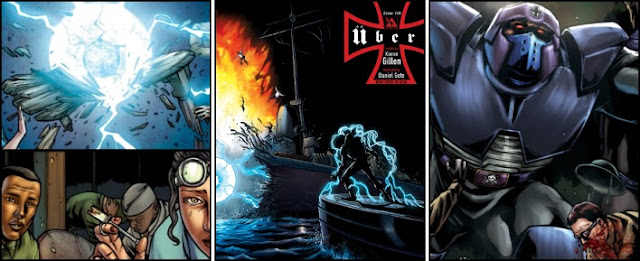 |
| STAR WARS No. 11, January 2016 |
Possibly far better known these days to “Star Wars” fans as
the man who rescued a partially-digested Boba Fett from the Sarlacc pit in K.W.
Jeter’s novelised trilogy “The Bounty Hunter Wars” than for his fleeting
appearance in the 1980 motion picture “The Empire Strikes Back”, this fourth
instalment of the “Showdown On The Smuggler’s Moon” story-arc provides the
‘capture or kill’ mercenary Dengar ample opportunity to show just how
formidably ruthless the Corellian was during the “period of renewed hope for
the Rebellion” immediately following the destruction of the (first) Death Star.
Indeed almost half of the twenty-page periodical is dedicated to showing the pilot
of the Punishing One somewhat simply out-brawl Chewbacca in a one-on-one
rooftop confrontation, courtesy of a shock bolt, a concussion grenade, some well-timed
kicks and punches, as well as a vibroblade.
Given just as much ‘screen time’ by Jason Aaron’s script as the disfigured "Payback",
though arguably a far less satisfying affair, is Luke Skywalker’s gladiatorial
bout with the gigantic “Kongo the Disemboweler”. Considering that the young aspiring
padawan is supposedly “the last of the Jedi”, it seems rather illogical that
Grakkus the Hutt, an obsessed “artefact collector” of the ‘long-dead’ order,
would throw away such a valuable, prized possession simply to momentarily entertain
a coliseum packed full of the planet’s ‘scum and villainy’, no matter how much
money “they’re paying to watch you die.”
It’s also rather artificially inconvenient for the “veteran
of many great battles all across the galaxy” to find himself facing a behemoth adorned
with so much “augmented… deep-core drilling armour” that “it won’t be easy to
hack” through and overcome his opponent, “not even with a lightsaber.” A
situation which makes this rather action-packed brutal battle appear more like
a contrived reimagining of the rebel’s (future) tussle with Jabba the Hutt’s Rancor in “Return
Of The Jedi”.
Fortunately however the Alabama-born writer’s narrative does
contain some notable surprises, of which the mighty Chewbacca’s defeat to the
viciously enraged Dengar is but one. Luke’s noticeably swift downfall at the
claws of the cybernetically-enhanced Kongo comes as no shock whatsoever,
especially when the “boy” decides that ‘closing his eyes and using the force’ is
the best option when faced with a rampaging killer of “giant man-eating lava
eels.” But Grakkus’ Gamesmaster being revealed as Imperial Agent 5241 must have
astonished many of this title’s 126,780 strong audience, as should have Han Solo’s
last minute appearance to save the life of his co-pilot in the comic’s final
few panels.
 |
| The regular cover art of "STAR WARS" No. 11 by Stuart Immonen |






















